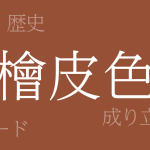Japan’s seasons are known for their vibrant colors, creating unique shades known as traditional Japanese colors. Among these, “Kuri-iro” (栗色 – くりいろ), with its natural warmth and depth, is deeply rooted in Japanese tradition and culture. This article delves deep into the allure of Kuri-iro, exploring its history, color code, and its Western name.
About Kuri-iro (栗色 – くりいろ)
Kuri-iro (栗色 – くりいろ), or chestnut color, is a deep reddish-brown reminiscent of the ripe fruit of the chestnut tree, and has been cherished in Japan for centuries. This calm yet profound shade features prominently in traditional Japanese attire, home décor, and even in contemporary design. Known as a symbol of autumn, Kuri-iro represents the richness of the harvest and a sense of serenity.
The History of Kuri-iro
Kuri-iro has been used in Japanese garments since the Heian period. It was a favorite among samurai and nobility, used in high-status or ceremonial contexts. Over time, Kuri-iro spread among the common people, becoming a staple in kimonos and accessories, and deeply integrating into the daily lives of the Japanese.
Color Code of Kuri-iro
To replicate Kuri-iro in digital design and web development, accurate color codes are essential. Here are the color specifications for Kuri-iro:
- HEX: #762F07
- RGB: R:118 G:47 B:7
- CMYK: C:52 M:87 Y:100 K:30
Western Name of Kuri-iro
In English, Kuri-iro is known as “Maroon.” The term originates from the French word “marron,” meaning chestnut. Maroon is recognized as a traditional color in the West as well, used widely in fashion and interior design.
Summary on Kuri-iro
With its depth and tranquility, Kuri-iro holds a long history as a traditional Japanese color. It remains undiminished in appeal, continuing to be cherished by many. The color code allows for its use in digital spaces, and its Western name, Maroon, facilitates international recognition. From formal settings to everyday use, Kuri-iro plays a special role in our lives.

























